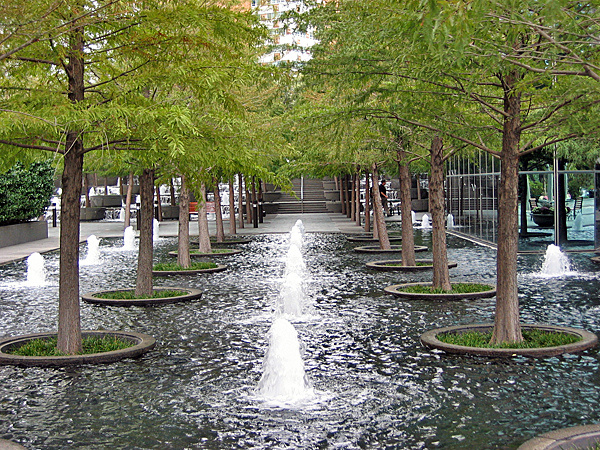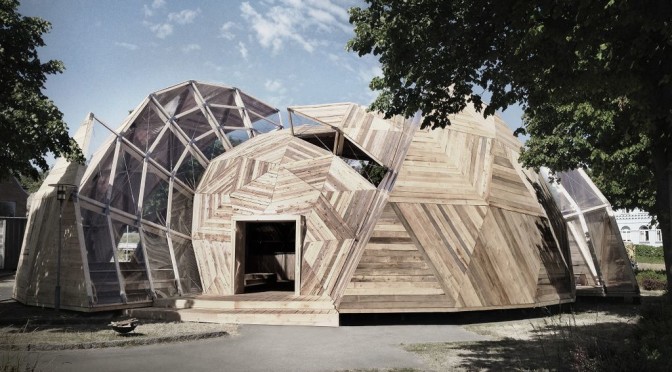On Wednesday, I had the honor to review Paige Geldrich’s Design Development presentation. Paige’s project has a very strong concept of “bringing old and new together”, it is very interesting and makes lots of sense due to the historical aspect of our site in Brooklyn. In the project, Paige designed a building with two wings that are parallel to the street around the edge of the site, they meet at the corner of the streets where a symbol of collision—- an 80 feet tower stands. To illustrate the concept, Paige decided to use material as the main tool to present the connection between past and future. One of the wings is built in red brick which echoes with the existing old brick buildings on our site. The other one that built by glass refers to the new and the future. It provides a strong contrast with the brick wing and the site.
Facades: The building is very impressive. It’s easy to tell that Paige has developed a logical organization in the design process. One of my favorite parts is the glass facade that is divided by the gird of frames and has some brick element at the bottom. It looks neat, responds the concept and interacts well with the method of interior design: using grid as an organized way to define the spaces. On other facades, Paige continued with the method to combine the brick and glass together, however, the way of arranging the blocks of materials could have been more thoughtful. Due to the different characteristic of the two materials, it is necessary to find a hierarchy. Right now it is a little hard for people to figure out the logic behind the composition. In the presentation, the guests questioned about the combination of brick and glass. I personally do not agree with that. Around our site, there are some buildings built by bricks and glass. They obviously have developed their tone which is homogeneous but outstanding. So I think Paige’s design totally makes sense.
Form: The arrangement of the massing is clear in this program. Height is increasing from the end of each wing to the eighty-feet-tall tower which emphasize the importance of the fire station. Moreover, some parts of the volume are cut out to create void spaces. It helps adding up the complexity and diversity of the building form. One thing I would suggest is to add up the height of the tower. Due to the width and the length of the building, the tower does not look as tall as it needs to be. As the building area is already large enough for all the program, adding up a smaller tower as a symbolic element might be a solution.
Programs: As I mentioned before, Paige used specific organizing grid to define the space within the wings. She reserved the brick wing with residential area and lounge area while the glass wing is occupied with the working area where the offices, maintenance area and apparatus bay located. She also came up with a sculptural and unique organization for the space in the tower. I think overall the programing works well, however, the following problems should be taken into consideration: 1. Will the height of the tower influence the speed of fire fighters to reach apparatus bay? 2. The project already has a very strong characteristic, the space inside the tower could be less sculptured, and a more flexible arrangement can make the movement smoother and can help to achieve a higher efficiency.3. Due to the plentiful of the space, the fire stairs and elevators can be set in somewhere reasonable instead of squeezing at the edge of the space.
Landscape: In the project statement, Paige talked about how the form of the buildings creates a frame that, along with the terraces and walk paths, encourages both firemen and other people to the public area along the water. I think her thought is great, however, it is not fulfilled yet in the shown design. The paths and landscape she has now is arbitrary comparing with the logical form of her building. The public space could be more coherent to the fire station and could be more welcoming by adding connections to the main streets.
Board: My favorite part of the board are the axons of the building. They are very detailed and well-made. By showing the shade and shadow, they tell a lot about the form of the building. I wish they could be larger and plays a more important role on board. The elevations and sections are beautiful as well, the line weight is appropriate and the textures are informative. It would be even better if Paige could add shadows as she did in the axons. It will definitely help the audiences better understanding her drawings. Moreover, the function of the area is only labeled on the first floor, to make the plans more clear, more dimensions and labels should be applied. The text is a little bit too large comparing to the drawings and the project statement is not fitted in an organized way. I believe these are just some tiny flaws that would be fixed next time.
Development: Comparing to the peer review, Paige had a better communication of the tower geometry through the models. I really appreciate that she put many efforts on her model so it can provides another way for us to better read the design. The other improvement is the site plan, although there are some problems that need to be figure out later, the site plan she had this time is obviously more informative and detailed.
Presentation: Paige was a little nervous at the beginning of the presentation and was not presenting very fluently. However as she kept going she pulled it back together. The presentation was overall clear and to the point. When the guests were critiquing, she was focused and can respond quickly with logic. I think it’s is a very important characteristic for an architect because it should her ability of critical thinking and her own deep understanding to the project.
Conclusion: Paige did a great job in this presentation. I think the challenge for the following month is to figure out the best way to use the two materials. Overall, the project is very interesting and well designed!






